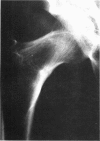Abstract
Tubular proteinuria is generally accepted as the critical effect following long-term, low-level exposure to cadmium as seen in an industrial environment. This effect may not be of immediate importance to the health of the individual, but the significance, in terms of long-term morbidity and mortality, of the renal tubular defect of which it is an indicator is not fully understood, and certain sequelae may have remained unrecognized due to inadequate follow-up.
Follow-up studies have been performed in nine of 12 workers who were initially investigated in 1962. In six of the men exposures ranged from 28 to 45 years to cadmium sulfide dust and for shorter periods in the earlier years to cadmium oxide fume and dust. These six men had tubular proteinuria when first seen, and this has persisted in the five survivors. All six men had hypercalciuria, and two of them became recurrent stone formers. One man whose urinary calcium excretion later fell to a low level more recently developed vitamin D resistant osteomalacia. In addition, each of the six men had exhibited some, but not all, of a variety of biochemical abnormalities related to other proximal renal tubular defects, and the worker who developed osteomalacia had additional evidence of a distal tubular defect. The five survivors also have evidence of slowly progressive deterioration in glomerular function.
Follow-up of this small group has shown that renal tubular dysfunction in cadmium workers may continue symptom-free for long intervals, but in a proportion of cases serious clinical effects may develop after a number of years.
Full text
PDF




Images in this article
Selected References
These references are in PubMed. This may not be the complete list of references from this article.
- Adams R. G., Harrison J. F., Scott P. The development of cadmium-induced proteinuria, impaired renal function, and osteomalacia in alkaline battery workers. Q J Med. 1969 Oct;38(152):425–443. [PubMed] [Google Scholar]
- GERVAIS J., DELPECH P. L'INTOXICATION CADMIQUE. Arch Mal Prof. 1963 Oct-Nov;24:803–816. [PubMed] [Google Scholar]
- KAZANTZIS G., FLYNN F. V., SPOWAGE J. S., TROTT D. G. Renal tubular malfunction and pulmonary emphysema in cadmium pigment workers. Q J Med. 1963 Apr;32:165–192. [PubMed] [Google Scholar]
- Nordin B. E. Hypercalciuria. Clin Sci Mol Med. 1977 Jan;52(1):1–8. doi: 10.1042/cs0520001. [DOI] [PubMed] [Google Scholar]
- Omdahl J. L., DeLuca H. F. Regulation of vitamin D metabolism and function. Physiol Rev. 1973 Apr;53(2):327–372. doi: 10.1152/physrev.1973.53.2.327. [DOI] [PubMed] [Google Scholar]
- Pujol M., Arlet J., Bollinelli R., Carles P. Tubulopathie des intoxications chroniques par le cadmium. Arch Mal Prof. 1970 Dec;31(12):637–648. [PubMed] [Google Scholar]
- Yoshiki S., Yanagisawa T., Kimura M., Otaki N., Suzuki M. Bone and kidney lesions in experimental cadmium intoxication. Arch Environ Health. 1975 Nov;30(11):559–562. doi: 10.1080/00039896.1975.10666776. [DOI] [PubMed] [Google Scholar]



